Unstable Scraps, Part 3
The last two weeks I've been sharing card-by-card stories about Unstable. I have more stories to share, so that means Part 3!
Krark's Other Thumb
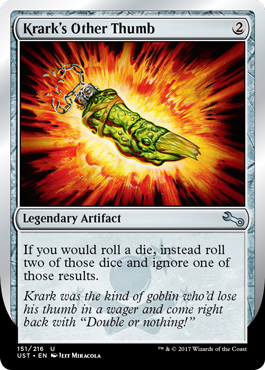
In Mirrodin, I made a card called Krark's Thumb that helped you get better coin flips.
Development was worried about it in multiples, so they asked if we could make it legendary. I said sure. So it went from Goblin Thumb to Krark's Thumb. It led to a lot of jokes internally about what happened to Krark's other thumb. We actually considered letting you have two, and only two, on the battlefield at a time, but it made coin flipping a little too consistent and we weren't interested in coin flips deciding games, so we went with it being a normal legendary artifact.
Fast-forward to Unstable's design. We'd decided to have a dice-rolling theme and I wanted to add some cards to help manipulate dice rolls. We were in a meeting when I said I wanted something like Krark's Thumb but for dice rolls. Two seconds later, it hit me and I started yelling, "Krark's Other Thumb! Krark's Other Thumb!"
The one other issue with this card was that I wanted it to be at a low enough rarity that it could matter in Limited, but if it was going to be Krark's Other Thumb, it had to be legendary. I went back and forth and finally decided the rarity mattered more than the awkwardness of having an uncommon legendary card. (We do it on rare occasions, but usually when legendary matters in some larger way in the set.)
Masterful Ninja
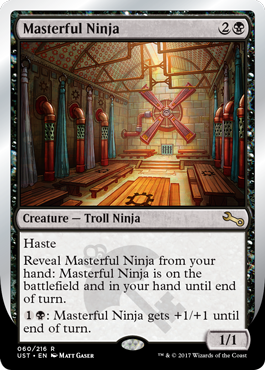
You'll see a recurring theme in a lot of these stories. We did something successful in a previous Un- set, so I made something new in Unstable that was similar but with a twist. In the case of Masterful Ninja, its predecessor was this card:
Yet Another Æther Vortex is my personal favorite card from Unhinged. It does something cool that you can build around and do cool Johnny things with, but with enough wackiness that the black-border rules wouldn't touch it. The card was very popular and is the card I get the most questions about, so I decided to make a new one.
Yet Another Æther Vortex allows a card to be in two zones at once, the library and the battlefield. Was there a way to do this again but with a different pair of zones? I wanted one to be the battlefield because that's where most of the action happens. I ended up with two choices, the hand or the graveyard. I designed both. The graveyard one ended up morphing into Over My Dead Bodies, so Masterful Ninja became my "in two zones at once" card.
What kind of card could be in your hand and on the battlefield at the same time? Probably something pretty sneaky. How about a Ninja? We chose to make the "also on the battlefield" effect something you could do easily, so we made it a reveal trigger. The cool thing about that is after you use it for the first time, you lose the surprise factor, so the reveal as a cost means something.
We made it small, a 1/1, and gave it a pumping ability so that if you wanted it to be bigger you'd have to dedicate some mana to it. We also gave it haste so you would be able to attack with it the turn you reveal it. Playtesting showed that this card allowed for a lot of cool moments that you don't normally see in black-bordered games.
Modular Monstrosity
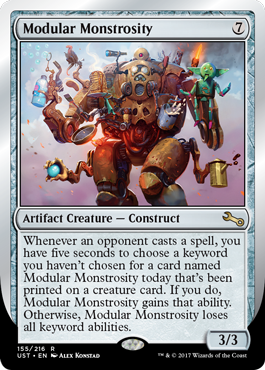
This creature came about because I was tickled by the idea that you got to build your own artifact creature by adding creature keywords over time. The first question I had to answer was what keywords could you choose from? As this was an Un- set, why not all the keywords? During our first playtest, my opponent played this card and named poisonous 10. Okay, we needed a little more restriction. How about any keyword that's ever been printed on a creature card? You could say poisonous 1 (Virulent Sliver) or monstrosity 10 (Colossus of Akros), but not poisonous 10. This would require some Magic knowledge, which is a theme I played up in both Unglued (Squirrel Farm) and Unhinged (My First Tome), but only if you wanted to be super-efficient. Flying and first strike would still work just fine.
The earliest version of Modular Monstrosity had the keyword addition happening at the beginning of your turn. Every turn, you got to add another keyword. In playtest, this was taking forever because people were always trying to optimize their choice. I solved this by borrowing from the stopwatch mechanic we'd tried earlier (see Hot Fix from last week for more on this) and adding a five-second limit. Name it quick or lose all the abilities on your Monstrosity.
Every turn ended up adding a few too many mechanics, so we decided to change the trigger. Instead of you triggering it, what if it was something your opponent did? This would make it happen at times you weren't expecting and add a little drama.
The final problem to solve was that we found people with experience with the card were creating an order that they were using by default every time. How do we make people change it up? The solution was a bit out of the box, but then that's one of the advantages of working in silver border. The original card didn't let you name something you'd already named that game. We changed it to something you already named that day. This forced you to get creative, as each time you used it in a tournament you had to try a different strategy.
I recommend you have a sheet of paper if you play Modular Monstrosity, so you can keep a list of everything you've already said.
Rules Lawyer
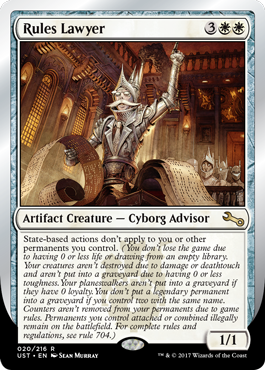
What was the most contentious card in the set? This one. Numerous people tried to remove it both in design and development. The card started with just a name. We liked Rules Lawyer as a creature, but the big question was, "What does it do?" Obviously, it needed to mess with the rules, but what rules? So we decided to go to the source and ask (then) rules manager Matt Tabak. We said we wanted Rules Lawyer to remove a rule from the game. Which rule would create the most chaos?
Matt came back with "Rule 704." He had a bit of an evil smile as he said it. The design team hadn't memorized the Comprehensive Rules, so we asked, "What's Rule 704?" Matt replied, "State-Based Actions." We looked up the rule and tried to understand all the ramifications. Basically, it was a Platinum Angel with an extra helping of nuttiness. With Rules Lawyer on the battlefield, you can't lose, your creatures can't die, and a bunch of things that normally stop you from doing odd things no longer do so. The trick was that we had to make sure that Rules Lawyer didn't affect itself so there was an answer for it.
We decided the card should list some, but not all, of what it meant to lose Rule 704 (it wouldn't all fit—I do list all the impacts in the FAQ, though). We liked that it would have tiny, dense text, as that played into the joke. We made the card and assumed we were done.
People would occasionally peek at the file and often leave a note saying things like "Really?" It was a weird card that did weird things, but I thought the flavor was great and it was the kind of thing I wanted Unstable to do in small chunks.
Then in development, Mark Purvis, senior brand director for Magic and one of the Marks that got this project made (see my first Unstable design story for how), joined the team, and he hated the card from the first moment he saw it. All through development he tried to kill it, but each time I would find allies to help me save it. It was actually in and out of the file a few times, but when the dust settled, it stayed in. We would later make a promo version of it for judges.
Shellephant
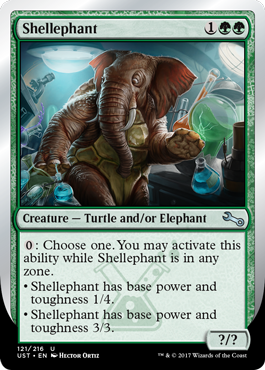
This card started out its life as a card called Elephurtle in a black-bordered set. I don't even remember which one—it was a while ago. It was a blue common 3/3 that could get -2/+1 until end of turn.
Elephurtle got dropped from the set it was in, but I always had a fondness for the concept. When Unstable came along, I decided it was time to bring Elephurtle to life. As it was an Un- set, I played around a little more with its ability to change between Elephant and Turtle. I'm happy to finally get Elephurtle to see print.
Spike, Tournament Grinder
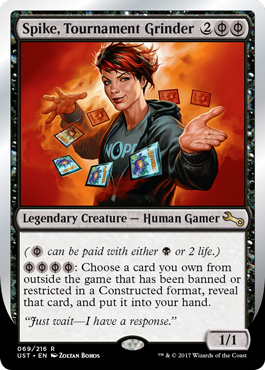
There weren't too many things I knew when we started designing Unstable, but one of them was that we were going to make a card for Spike.
We'd made a card for Timmy in Unglued and a card for Johnny in Unhinged, so it was pretty much a fait accompli (something that was definitely going to happen). The card was designed by Dan Emmons pretty early in design (you know, the first two years or so). We liked the mix of Phyrexian mana with the ability to Burning Wish for a banned or restricted card. Development tweaked the numbers, but the card never changed from its initial design.
My favorite story with Spike happened during a development playtest. I got it in my card pool, so I put it in my deck. I drew it and played it and then realized that I needed a banned or restricted card. So, I quickly ran to the cabinet that has all of R&D's cards, but most the powerful stuff was long gone, so I was trying to think of something that we might have that would actually be in the cabinet.
Then I remembered that when Legends first came out, there was a rule that all legendary creatures were restricted. I went to the Legends box, which mostly had random low-powered commons and uncommons that hadn't disappeared into decks over the years, and found this card:
I grabbed it, played it, and won the game with it. Mark Purvis was so embarrassed by this that he brought me a From the Vault: Exiled for use in all future playtests.
Super-Duper Death Ray
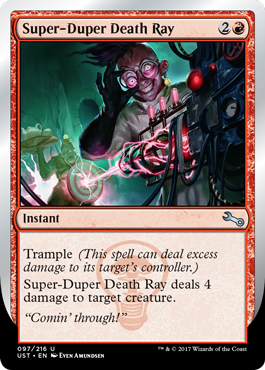
In Odyssey design, I came up with a cool idea. I made a direct-damage spell with trample. The idea was pretty simple. You would deal 5 damage to a creature, and anything left over would trample to its controller. Here's what that card turned into:
Not quite what I had originally imagined. It turns out the way the trample rules are written, you can't just put it on a direct-damage spell. I tried various other times to make versions that worked in black border, but none had the elegance I wanted.
When Unhinged came out, I realized I'd missed my opportunity to make a direct-damage spell with trample. I'd simply forgotten about it, so I made a vow that if I ever made a third Un- set, I would include it. And I did.
Sword of Dungeons & Dragons

This card started with just a name. We'd been talking about making a joke about the Sword of Blank and Blank cycle from Mirrodin and Scars of Mirrodin blocks, so we started writing down names that we found funny. One of the names we got was Sword of Dungeons & Dragons. We'd been talking about how it would be fun at some point to make a nod to Wizards' other big game, so we designed a card with plans to talk to the Dungeons & Dragons brand team to get permission.
The original version was similar (the structure is based off the original cycle), but we had a few differences. First, the card rolled three six-sided dice (it's an iconic part of D&D character building and it allowed us to use six-sided dice, which were a theme of the set) and made a Beholder token. For those unfamiliar with Dungeons & Dragons, the Beholder is a many-eyed flying monster that's unique to D&D.
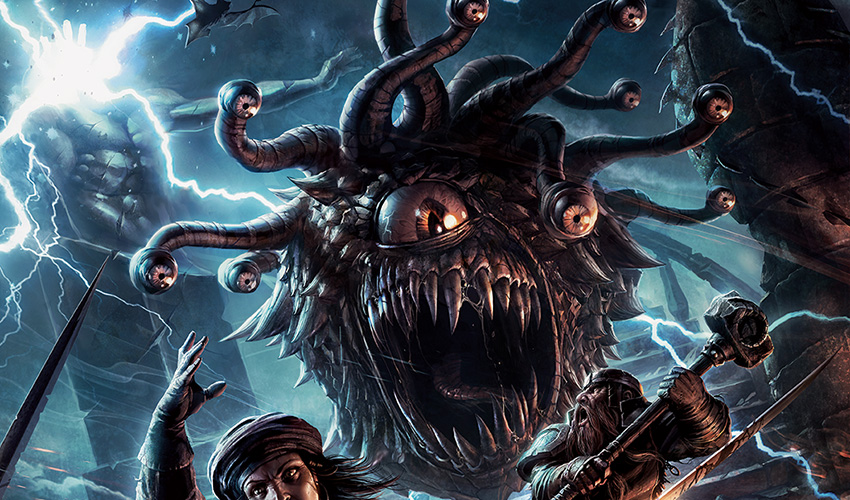
Magic doesn't have any Beholders, so I liked the idea that we were doing something uniquely D&D. But the D&D team asked if we could change it to a Dragon, as obviously it's the most iconic creature in their game (being in the name and all). We changed it to a gold Dragon—that's literally the color gold—so it would at least be a little off the beaten path. They also asked if we could roll a 20-sided die, as that's another icon of the game.
The one other change came after the art was in. The original version had protection from Wizards and Clerics. To match the cycle, we needed protection from two things, and using creature classes found in both games seemed like the ideal choice. We had the D&D team look at the art to make sure they were happy with it (they were), and they made the note that the weapons pictured were better suited for a Rogue and a Cleric than a Wizard and a Cleric. We changed the card to reflect that.
The final piece of this story came about when others were working on the cards for HASCON. They wanted each card to reference a different Hasbro IP and realized Sword of Dungeons & Dragons was a perfect fit, so they asked if they could include it. We said yes. Note that the HASCON version is functionally different in that it has a Dungeons & Dragons watermark, meaning it can be cast with Watermarket while the Unstable version cannot.
Urza, Academy Headmaster
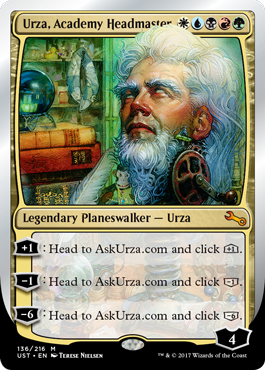
In the Invasion block story, there's a fight between Gerrard and Urza where Gerrard cuts off Urza's head. Urza doesn't die immediately, though. He continues on for a while as a disembodied head. Now, he does eventually die, but for Unhinged, I decided to explore the comedy potential if he didn't die but continued living on as a disembodied head.
I figured Urza had a lot of resources. He wouldn't let a thing like not having a body slow him down. There was another gag we had where a character ripped himself out of his art and we wanted to show him on another card. What would make him rip himself out of his own art? What if he went someplace really nice? I was also playing into the joke that a lot of artifacts are Urza's, so what if Urza had a nice hot tub? Who wouldn't pull out of their art to rest in a nice hot tub? And, of course, Urza should be there living it up. I wanted disembodied-head Urza to be happy.
Fast-forward to Unstable design. I knew that I wanted an Un-planeswalker. One of the cool things about doing new Un- sets is playing in new space created since that last Un- set was made. One of those cool new things was planeswalker cards. The big question was which planeswalker to choose. I had some options, but I was pulled toward disembodied-head Urza for a few reasons. One, players have been asking for an Urza planeswalker card forever. Two, Urza is all five colors, and players have also been asking for a five-color planeswalker forever. Three, I often get asked about disembodied-head Urza, and I felt I would be remiss not to show him in Unstable. So, he was my first choice for my Un-planeswalker.
The big question was, what should he do? This is where we pulled an idea for a different card. With the advent of smart phones, it's become very easy to access the internet. I liked the idea of having a card where you didn't know exactly what was going to happen. You would have to log in and see. The card would have some mystery and I decided that worked well with it being Urza. Urza is the ultimate man of mystery, so it seemed like a good flavor fit. And that's how Urza, Academy Headmaster came to be.
X
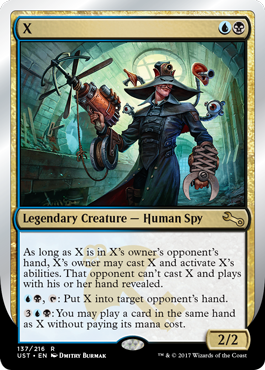
The idea behind this card was we wanted it to be a super-spy character. What wacky thing could we do to capture that? The idea we came up with was to have the card infiltrate your opponent's hand. What exactly did that mean, though? Okay, obviously you put the card into their hand. First off, it would report back to you and tell you what was in their hand, so the hand needed to be revealed. The other cool thing would be for it to cast spells out of your opponent's hand, so we added that.
The first playtest, I put it into my opponent's hand and they cast it. Oops. We added the rider that they couldn't cast or activate the creature. The second ability also originally made you pay for the ability (the activation cost was cheaper), but it reduced how often you could actually cast cards, so we raised the second activation's cost and allowed you to cast it without paying the mana cost.
X got his name because Kelly realized that although Magic (through Un- sets) has done names with zero letters (Unhinged's _____) and two letters (Unglued's Ow), we had never done a one-letter name. X seemed to be a perfect choice.
The last thing is, I wrote flavor text that I loved for this card but there wasn't room for it, so for the first time I present X's flavor text:
X spots the mark.
Unstable and Ready
That's all the stories I have time for today. I hope you enjoyed hearing about how many of Unstable's cards came to be. As always, I'm eager to hear feedback. You can email me directly or contact me through any of my social media (Twitter, Tumblr, Google+, and Instagram).
This is going to be my last week of new content in 2017. The next two weeks will be best-of weeks where I share my favorite columns with all of you. In three weeks, I'll return with the start of Rivals of Ixalan previews.
Until then, please, please, please give Unstable a try. It's a really fun set.
#494: Kicker
#494: Kicker
28:55
In this podcast, I talk all about the history of the kicker mechanic, from its start in Invasion to modern day.
#495: Vision, Set, and Play Design
#495: Vision, Set, and Play Design
32:15
Last year, R&D changed the structure of how we make Magic cards. In this podcast, I explain the change and introduce the three new parts of Magic design in R&D.
- Episode 493 20 Lessons: Challenging Players (21.0 MB)
- Episode 492 Printing (22.1 MB)
- Episode 491 Being Spokesperson (21.8 MB)

